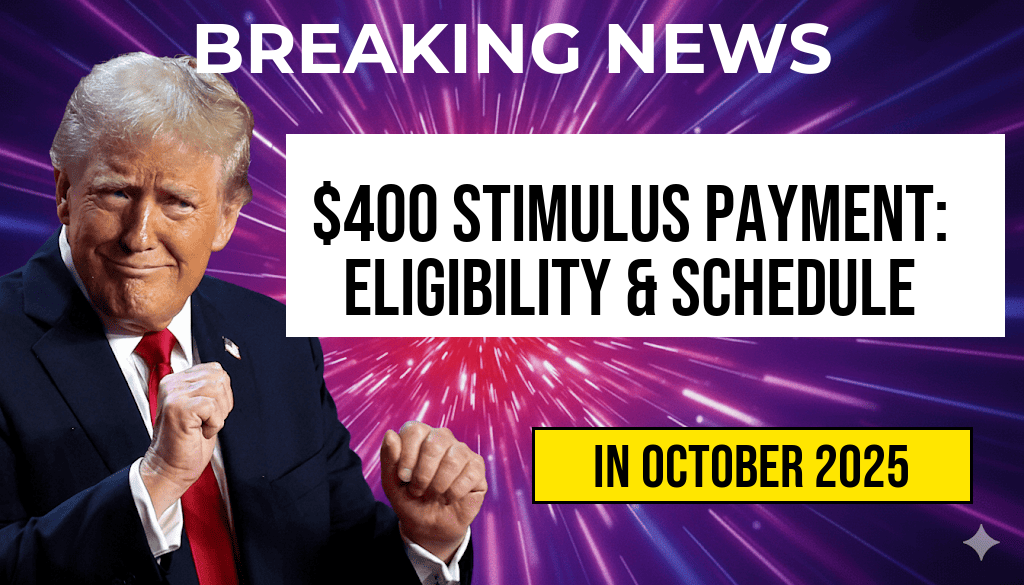A new federal stimulus initiative is offering a $400 stimulus payment to eligible individuals nationwide, aiming to provide financial relief amid ongoing economic challenges. The program, announced by government officials, extends benefits to a broad segment of the population, with specific eligibility criteria designed to target working families and low-to-moderate income earners. The payments are scheduled to be distributed over several weeks, with the first wave expected to begin as early as next month. This initiative marks a significant effort by federal authorities to stimulate economic activity and support households facing rising costs of living, including inflation in housing, fuel, and groceries.
Who Qualifies for the $400 Stimulus Payment?
Basic Eligibility Criteria
- Residency Status: Applicants must be U.S. residents or citizens with valid identification.
- Income Limits: Households earning up to $75,000 annually for individuals and $150,000 for joint filers are eligible.
- Tax Filing Status: The payment is primarily available to those who filed a federal tax return for the previous year or are registered for Social Security benefits.
- Employment Status: Both employed and unemployed individuals qualify, provided they meet income criteria.
Additional Considerations
- Dependents under 18 can be included, increasing the total amount a household might receive.
- Recipients of certain government assistance programs, such as SNAP or Medicaid, automatically qualify.
- Individuals with prior debts owed to federal agencies may face offsets, reducing the payment amount.
How and When Will the Payments Be Distributed?
Federal officials have outlined a phased distribution schedule, with payments beginning in the upcoming month. The distribution process is expected to span over several weeks, allowing for administrative processing and verification. Payments will be directly deposited into bank accounts linked to the taxpayer’s filing information or sent via paper checks for eligible recipients without direct deposit details.
Payment Schedule Overview
| Distribution Phase | Expected Start Date | Targeted Recipients |
|---|---|---|
| Initial Wave | Next month, first week | Tax filers with direct deposit info |
| Second Wave | Following two weeks | Paper check recipients and late filers |
| Final Phase | End of the month | Remaining eligible households |
How to Ensure You Receive Your Payment
Steps for Eligible Individuals
- Verify Eligibility: Review income and residency requirements on the official government portal.
- Update Contact Information: Ensure your banking details or mailing address are current with the IRS or relevant agencies.
- File or Update Tax Returns: If you haven’t filed recently, submitting a tax return or updating your information can facilitate faster processing.
- Monitor Payment Status: Use online portals such as the IRS ‘Get My Payment’ tool to track your payment.
Additional Resources and Important Notices
Officials emphasize that the program is designed to be inclusive, with minimal barriers for qualifying households. However, individuals should be wary of scams or fraudulent schemes claiming to expedite or guarantee payments. All official communications will come through verified channels, and the government has set up a dedicated website for inquiries: IRS Get My Payment.
For more detailed information about the eligibility criteria, visit Congressional legislation or consult trusted news outlets such as Forbes or reputable government sources like the USA.gov portal.
Frequently Asked Questions
Question
Who is eligible to receive the $400 Stimulus Payment?
Question
What are the eligibility criteria for obtaining the stimulus payment?
Question
When is the complete payment schedule for the $400 stimulus payment?
Question
How can individuals check their payment status or if they have received the stimulus?
Question
Are there any additional requirements or documentation needed to qualify for the stimulus payment?
A new federal stimulus initiative has announced a $400 stimulus payment available to eligible Americans, aiming to provide financial relief amid ongoing economic challenges. This program is designed to support individuals and families by delivering direct payments on a structured schedule, with specific eligibility criteria that vary based on income, employment status, and recent economic hardship. The payments are part of broader efforts to stabilize the economy and assist those most impacted by inflation and rising living costs.
Details of the $400 Stimulus Payment Program
The stimulus payments are scheduled to be distributed in multiple phases over the coming months, with the goal of reaching millions of Americans. Unlike previous relief efforts, this program emphasizes targeted support, focusing on households that demonstrate financial need. The payments are intended as a one-time benefit, although ongoing assistance programs may be available for qualifying individuals.
Who Is Eligible for the $400 Payment?
Eligibility hinges on several criteria, including income thresholds, employment status, and recent participation in federal assistance programs. Eligible recipients must meet the following general requirements:
- Income Limits: Household income must fall below $75,000 for individuals or $150,000 for married couples filing jointly.
- Residency: Applicants must be U.S. residents or citizens, with proof of residency status.
- Employment Status: Those unemployed or experiencing a significant reduction in income due to COVID-19 or other economic factors are prioritized.
- Participation in Assistance Programs: Recipients of SNAP, TANF, or unemployment benefits are automatically considered eligible.
Individuals who do not meet these criteria may still qualify if they can demonstrate financial hardship through other documentation. The program aims to be inclusive but maintains strict guidelines to ensure aid reaches those in need.
Application Process and Documentation
Eligible individuals will need to submit an application through designated government portals or local agencies. The process involves verifying personal information, income documentation, and residency status. Applicants should prepare:
- Recent pay stubs or proof of unemployment benefits
- Tax returns or income statements
- Identification documents, such as a driver’s license or passport
Most applications can be completed online, with assistance available via phone or local community centers for those lacking internet access. Processing times are expected to vary but are generally within two to four weeks after submission.
Complete Payment Schedule
The distribution plan for the $400 stimulus payments is structured into several phases, with initial disbursements starting as early as next month. The schedule is as follows:
| Phase | Expected Date | Target Recipients |
|---|---|---|
| Phase 1 | May 2024 | Low-income households, unemployment claimants |
| Phase 2 | June 2024 | Recipients of federal assistance programs |
| Phase 3 | July 2024 | Other eligible residents, based on application processing |
Recipients will receive the payments via direct deposit into their bank accounts or through prepaid debit cards mailed to their addresses. The government has emphasized transparency and timely delivery, with updates available through official channels.
Additional Support and Resources
Eligibility criteria and payment details are subject to change as new policies are implemented. For the latest information, individuals are encouraged to consult the official [U.S. Department of Treasury](https://home.treasury.gov) website or local assistance agencies.
Those seeking further guidance can also explore resources provided by reputable outlets such as [Forbes](https://www.forbes.com) or [Wikipedia](https://en.wikipedia.org/wiki/Financial_aid_in_the_United_States), which offer comprehensive overviews of federal relief programs and economic assistance initiatives.
Eligible residents should monitor their mail and bank accounts closely over the coming months to ensure receipt of the funds. This initiative underscores the ongoing efforts by federal authorities to mitigate economic hardship and promote financial stability across diverse communities.
Frequently Asked Questions
Question
Who is eligible to receive the $400 stimulus payment?
Eligible recipients include individuals and families who meet specific criteria outlined by the authorities, such as income thresholds and residency requirements. Details vary by region and program.
Question
What are the eligibility criteria for receiving the $400 stimulus payment?
To qualify, applicants generally must reside in the eligible area, have a valid income level below a specified threshold, and submit necessary documentation by the designated deadline.
Question
When will the payment schedule be announced and what are the key dates to remember?
The payment schedule will be detailed by authorities, with disbursements expected to begin on specific dates. It is important to stay updated through official channels for timely information.
Question
How can eligible individuals apply for the $400 stimulus payment?
Applications can typically be submitted via online portals, mail-in forms, or at designated offices. Ensure all required documentation is complete to avoid delays.
Question
Are there any additional benefits or related payments available alongside the $400 stimulus?
Depending on the program, recipients may also be eligible for other financial assistance or support programs. Check official guidelines to learn about potential additional benefits.






